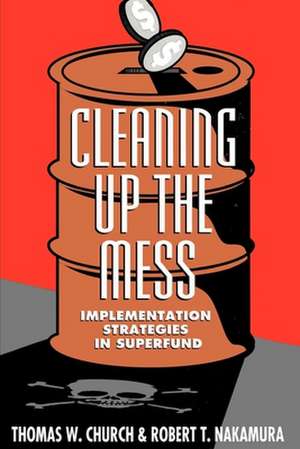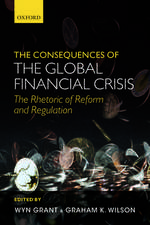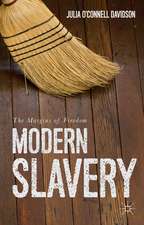Cleaning Up the Mess: Implementation Strategies in Superfund
Autor Thomas W. Church, Robert T. Nakamuraen Limba Engleză Paperback – feb 1993
The federal Superfund program for cleaning up America's inactive toxic waste sites is noteworthy not only for its enormous cost - $15.2 billion has been authorized thus far - but also for its unique design. The legislation that created Superfund provided the Environmental Protection Agency with a diverse set of policy tools. Preeminent among them is a civil liability scheme that imposes responsibility for multimillion dollar cleanups on businesses and government units linked - even tangentially - to hazardous waste sites. Armed with this potent policy implement, the agency can order the parties who are legally responsible for the toxic substances at a site to clean it up, with large fines and damages for failure to comply. EPA can also offer conciliatory measures to bring about voluntary, privately financed cleanup; or it can launch a cleanup initially paid for by Superfund and later force the responsible parties to reimburse the government.
In this book, Thomas W. Church and Robert T. Nakamura provide the first in-depth study of Superfund operations at hazardous waste sites. They examine six Superfund cleanups, including three regions and both 'hard' and 'easy' sites, to ask 'what works?' Based on detailed case studies, the book describes various strategies that have been applied by government regulators and lawyers and the responses to those different strategies by businesses and local government officials.
The authors characterize the implementation strategies used by the EPA as prosecution, accommodation, and public works. They point out that the choice of strategy involves setting priorities among Superfund's competing objectives. They conclude that the best implementation strategy is one that considers the context of each site and the particular priorities in each case. Looking toward the reauthorization of Superfund, they also offer recommendations for improvements in the organization of the program and discuss proposals for change in its liability scheme.
In this book, Thomas W. Church and Robert T. Nakamura provide the first in-depth study of Superfund operations at hazardous waste sites. They examine six Superfund cleanups, including three regions and both 'hard' and 'easy' sites, to ask 'what works?' Based on detailed case studies, the book describes various strategies that have been applied by government regulators and lawyers and the responses to those different strategies by businesses and local government officials.
The authors characterize the implementation strategies used by the EPA as prosecution, accommodation, and public works. They point out that the choice of strategy involves setting priorities among Superfund's competing objectives. They conclude that the best implementation strategy is one that considers the context of each site and the particular priorities in each case. Looking toward the reauthorization of Superfund, they also offer recommendations for improvements in the organization of the program and discuss proposals for change in its liability scheme.
Preț: 199.11 lei
Nou
Puncte Express: 299
Preț estimativ în valută:
38.10€ • 39.88$ • 31.71£
38.10€ • 39.88$ • 31.71£
Carte tipărită la comandă
Livrare economică 31 martie-14 aprilie
Preluare comenzi: 021 569.72.76
Specificații
ISBN-13: 9780815714132
ISBN-10: 0815714130
Pagini: 223
Ilustrații: black & white illustrations
Dimensiuni: 152 x 229 x 14 mm
Greutate: 0.35 kg
Editura: Brookings Institution Press
Colecția Brookings Institution Press
ISBN-10: 0815714130
Pagini: 223
Ilustrații: black & white illustrations
Dimensiuni: 152 x 229 x 14 mm
Greutate: 0.35 kg
Editura: Brookings Institution Press
Colecția Brookings Institution Press
Notă biografică
Thomas W. Church is a professor of Political Science and Public Policy at the Rockefeller College of Public Affairs and Policy of the State University of New York at Albany. He has published published extensively on environmental policy, court reform, and the nexus of law and policy. Robert T. Nakamura is a professor of Political Science and Public Policy at the Rockefeller College of Public Affairs and Policy of the State University of New York at Albany. His research has focused on environmental policy and policy implementation.
Descriere
The federal Superfund program for cleaning up America's inactive toxic waste sites is noteworthy not only for its enormous cost - $15.2 billion has been authorized thus far - but also for its unique design. The legislation that created Superfund provided the Environmental Protection Agency with a diverse set of policy tools. Preeminent among them is a civil liability scheme that imposes responsibility for multimillion dollar cleanups on businesses and government units linked - even tangentially - to hazardous waste sites. Armed with this potent policy implement, the agency can order the parties who are legally responsible for the toxic substances at a site to clean it up, with large fines and damages for failure to comply. EPA can also offer conciliatory measures to bring about voluntary, privately financed cleanup; or it can launch a cleanup initially paid for by Superfund and later force the responsible parties to reimburse the government.
In this book, Thomas W. Church and Robert T. Nakamura provide the first in-depth study of Superfund operations at hazardous waste sites. They examine six Superfund cleanups, including three regions and both 'hard' and 'easy' sites, to ask 'what works?' Based on detailed case studies, the book describes various strategies that have been applied by government regulators and lawyers and the responses to those different strategies by businesses and local government officials.
The authors characterize the implementation strategies used by the EPA as prosecution, accommodation, and public works. They point out that the choice of strategy involves setting priorities among Superfund's competing objectives. They conclude that the best implementation strategy is one that considers the context of each site and the particular priorities in each case. Looking toward the reauthorization of Superfund, they also offer recommendations for improvements in the organization of the program and discuss proposals for change in its
In this book, Thomas W. Church and Robert T. Nakamura provide the first in-depth study of Superfund operations at hazardous waste sites. They examine six Superfund cleanups, including three regions and both 'hard' and 'easy' sites, to ask 'what works?' Based on detailed case studies, the book describes various strategies that have been applied by government regulators and lawyers and the responses to those different strategies by businesses and local government officials.
The authors characterize the implementation strategies used by the EPA as prosecution, accommodation, and public works. They point out that the choice of strategy involves setting priorities among Superfund's competing objectives. They conclude that the best implementation strategy is one that considers the context of each site and the particular priorities in each case. Looking toward the reauthorization of Superfund, they also offer recommendations for improvements in the organization of the program and discuss proposals for change in its

















